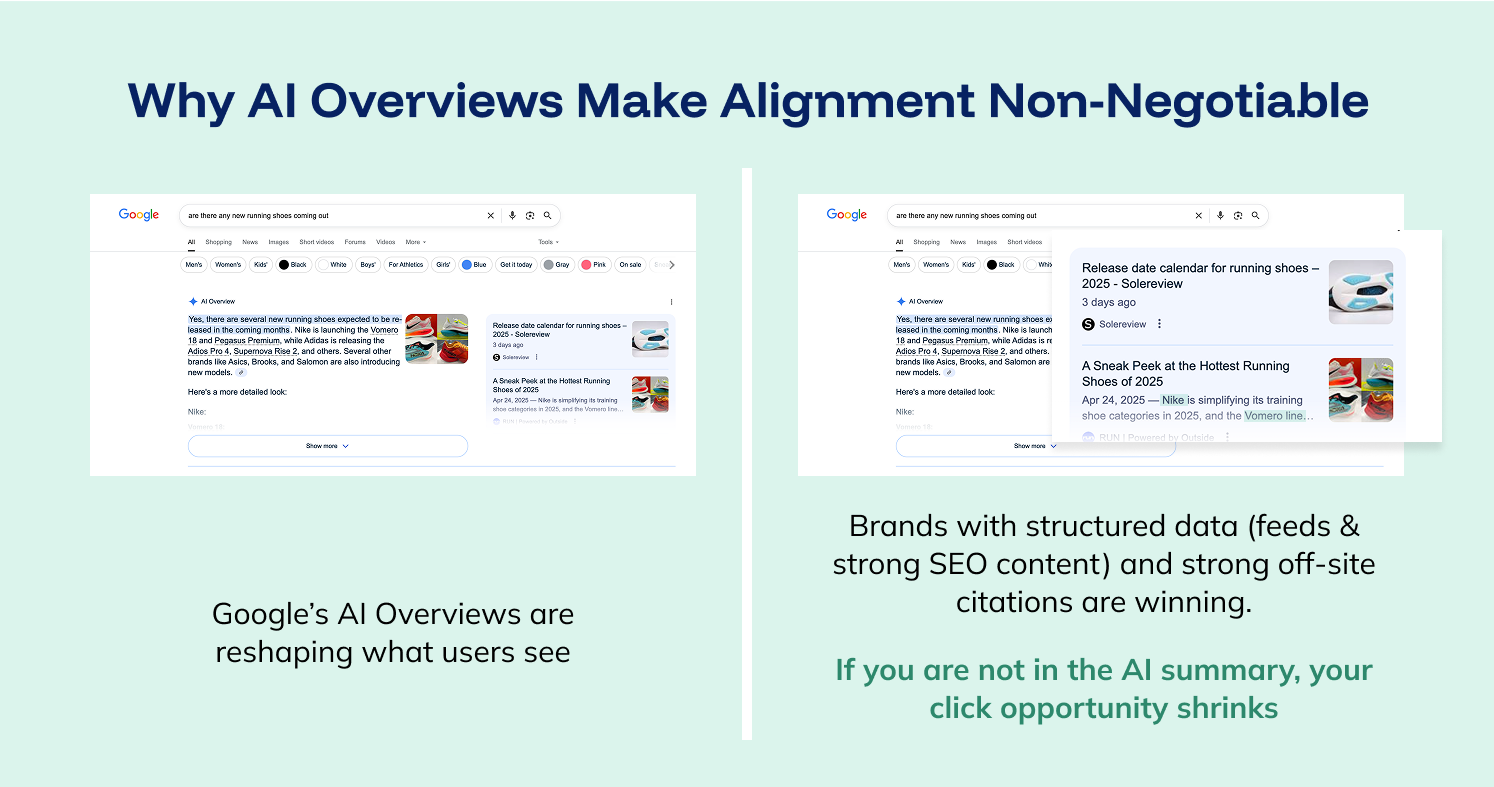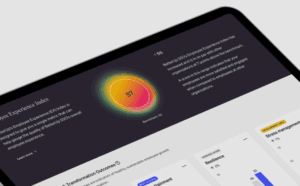Home / Blog / Google vs. ChatGPT: How AI Is Reshaping Search Visibility
AI Ai overviews chatgpt digital marketing Go Fish Digital Google Search seo
Google vs. ChatGPT: How AI Is Reshaping Search Visibility
Published: August 05, 2025• Updated: August 05, 2025
Share on LinkedIn Share on Twitter Share on Facebook Click to print Click to copy url

Contents Overview
The way people search for information is changing quickly. For years, Google’s been the gateway to the internet. But that grip is loosening, and AI is the reason.
At a recent roundtable, Go Fish Digital’s marketing experts broke down what’s happening behind the scenes. Tools like ChatGPT are changing how users look for answers, and Google is racing to adapt. Rankings and keywords are no longer the full picture. The bigger question now is how your brand shows up when users don’t even open Google.
This blog covers what’s driving the shift, why it matters, and how you can stay visible.
Google’s AI Push Is Urgent, Not Just Innovative
Google’s launch of Search Generative Experience (SGE) and Gemini isn’t just a bold move. It’s a necessary one.
“They’ve got to show up differently and regain share, or they’re going to keep losing,” said David Dweck, EVP and GM of the E-Commerce Division.
After meeting with Google leadership, David saw just how strongly they view this shift. Users no longer want ads and blue links. They want fast, clear answers.
That push has pushed Google into reactive mode. Their updates aren’t innovation for innovation’s sake; they are about survival.
Adobe reports that over 55% of consumers already use AI-powered search for research and recommendations, and 47% rely on these tools for purchase decisions, showing this change isn’t speculative; it’s happening now.
Here’s how we at Go Fish Digital are responding:
- Our “How to Use SEO to Show Up in ChatGPT and AI Overviews” webinar breaks down the exact content structure and citation tactics brands need to earn AI visibility
The ChatGPT Effect: When Search Starts Somewhere Else
One of the biggest shifts is where users begin their search.
“Why go to Google when ChatGPT already has the answer?” asked Chris Long, Vice President of Marketing.
He’s right. AI tools reduce friction. Instead of scanning a list of articles, users ask a question and get a direct, summarized response.
A five-step process becomes a one-step conversation.
That matters because Google is no longer the automatic first stop. People now rely on AI tools for both quick answers and deeper research. Google is trying to keep up through SGE, but user habits have already changed, and ChatGPT has their attention.
What This Means for Marketers
Traditional SEO playbooks were built around one goal: ranking high on Google. You optimized for keywords, built links, and watched for traffic.
That approach doesn’t work the same way in an AI-first environment.

Today’s user journey is anything but linear. Before converting, people often bounce between platforms, revisit pages, and interact with both AI results and paid placements. Visibility isn’t a single moment. It’s a strategy that spans the entire funnel.
Now, when someone asks ChatGPT or Gemini a question, your website might be the source, but the user may never see it. The AI chooses what to show, how to phrase it, and who gets credit. If your content isn’t quoted or linked, it’s invisible.
To stay in the game, you need more than search rankings. You need content that earns trust from AI.
4 Ways to Boost AI Visibility
If you want your brand to appear in AI-generated answers, your content needs to earn that spot. It’s no longer enough to rank. You need to become a trusted source that AI models choose to feature.
Start here:
1. Structure Content for Scanability
AI models look for clean, well-organized information. Make your content easy to parse by using:
- Clear headings (H1, H2, H3).
- Bullet points and numbered lists.
- FAQs or question-based formats.
- Schema markup (such as FAQ or How-To schema).
These elements help AI extract relevant details and deliver your content as part of a response.
2. Be Quotable
Think like a journalist’s source. Your content should deliver insights that are clear, original, and ready for attribution. Craft concise, impactful statements that can stand on their own.
Examples:
- “Google’s AI updates aren’t about innovation. They’re about survival.”
- “In AI-first search, trust is the new ranking factor.”
If a model can lift your sentence and drop it into an answer, you’ve done your job.
3. Optimize for Questions, Not Just Keywords
AI tools respond to conversational queries, not just search terms. Update your content to reflect the way real people ask questions.
Instead of focusing on phrases like “B2B SEO strategy,” address specific user questions:
- “How can B2B brands improve SEO in an AI-first world?”
- “What does ChatGPT mean for Google search traffic?”
This mirrors how users interact with AI tools, and how those tools are trained to deliver results.
4. Prioritize EEAT: Experience, Expertise, Authoritativeness, Trustworthiness
Google still values EEAT, and so do AI models. These signals help determine whether your content is credible enough to feature.
Strengthen your content’s authority by:
- Adding author bios with real experience.
- Sharing case studies, examples, or data.
- Using HTTPS and current contact information.
- Avoiding clickbait or generic filler.
When your content is trustworthy, AI is more likely to use and credit it.
Why SEO Still Matters
Search isn’t dead. It’s evolving.
Keywords, metadata, and technical SEO still matter. But in today’s landscape, they’re just the baseline. Quality, clarity, and authority now play a bigger role.
Think of traditional SEO as your foundation. AI visibility builds on top of that. You need both to succeed. The goal is to get crawled, understood, and selected as the answer, whether it’s by Google or an AI assistant.
What’s Coming: The 2025 Tipping Point
Go Fish Digital’s experts see a major shift coming fast. By the end of 2025, you can expect:
- AI-generated answers dominating the top of search results.
- SGE is becoming the default search experience, not just an experiment.
- Organic traffic falling for broad or how-to queries.
- Brand visibility spread across platforms like ChatGPT, Gemini, and Perplexity.
This shift isn’t just disruptive. It’s a chance to lead.

“Alignment is non-negotiable in AI overviews. Showing up there is crucial because these overviews are becoming the new search results page,” said David Dweck, EVP and GM of the E-Commerce Division.
Brands that act now, by auditing content, improving clarity, and building trust, will be the ones users see first.
What You Can Do Today
Getting ahead doesn’t require a full rebuild. It takes a smart, focused plan.
Here’s where to start:
- Audit your content library. Update high traffic pages to be AI-readable and question-focused.
- Add structured data. Use schema to help AI find and understand your content.
- Write conversational content. Answer real questions instead of chasing keywords.
- Track AI visibility. New tools are emerging to help you monitor when your content appears in AI-generated responses.
CTA: Ready to Stay Visible?
Search is changing fast. If your brand is still playing by the old rules, it’s time to evolve.
Go Fish Digital helps teams navigate this shift with strategic content audits, AI visibility playbooks, and SEO built for what’s next.
Want to stay in front as AI reshapes the search game?
Let’s talk.
Get your free AI Visibility Audit
About Kimberly Anderson-Mutch
MORE TO EXPLORE
Related Insights
More advice and inspiration from our blog
Top Generative Engine Optimization (GEO) Agencies and Thought Leaders
Generative Engine Optimization (GEO) — sometimes referred to as AEO (Answer...
Patrick Algrim| August 08, 2025
Use Screaming Frog Custom JavaScript to Pull Google Search Results for Your Pages Target Topics
One of the most efficient ways to understand how Google might...
Dan Hinckley| August 06, 2025
Why Clicks Don’t Count: What the Best CMOs Are Tracking Now
Clicks don’t tell the whole story anymore. AI is reshaping how...
Kimberly Anderson-Mutch| August 05, 2025





